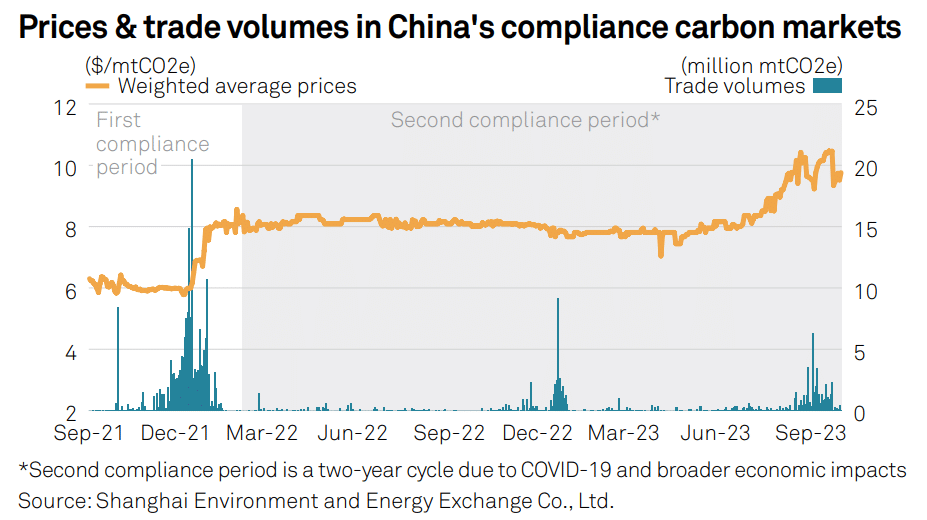The Ministry of Ecology and Environment (MEE) in China released guidelines signalling the revival of the domestic voluntary carbon market (VCM), alongside revealing the rules for account registration, giving final touches on the market’s reboot.
China’s VCM, known as China Certified Emission Reduction (CCER), restarted after a six-year hiatus. The market had been paused since 2017 for new project registrations while the government sought to strengthen regulatory frameworks.
The Role of China’s Voluntary Carbon Market
China introduced its national compliance emissions trading system (ETS) in 2021, being one of the first Asian countries to do so. The world’s largest in terms of emissions covered, China’s ETS is estimated to account for >40% of its carbon emissions. This footprint is largely from its power sector.
After the completion of the first compliance period for China’s ETS, the government has been preparing to relaunch its CCER.
- READ MORE: China Ready to Reboot Carbon Scheme
The discontinuation of the CCER plan in 2017 was due to low trading volumes and inadequate carbon audit standards. With the establishment of China’s national ETS, the revival of the CCER system gained momentum, aiming to address previous shortcomings and bolster carbon reduction efforts.
Under CCER, carbon emitters compensate credit-holding entities, such as renewable energy producers, for their credits. These voluntary CCER credits allow companies within the compliance markets, ETS, to offset their emissions.
They can be used to cover shortfalls in China Emissions Allowances (CEAs) or as tradable credits within the national ETS. But their use for offsetting emissions is restricted to only 5% of emissions exceeding the national ETS targets.
Earlier this year, the MEE introduced new legislation and approved 4 methodologies for CCER credit issuance, clearing the path for new projects and supplies to enter the market. The Beijing Green Exchange, to host the trading platform for CCER credits, also issued rules for CCER trading and settlement.
VCM Complementing the Compliance Market
China’s VCM reopening may increase supplies for compliance market companies, allowing them to use the credits to offset their emissions.

Since 2021, the compliance carbon price hit a record of $10.12/mtCO2e on August 18, surpassing the $10/mtCO2e mark for the first time. This ETS price traded 4x – 5x that of international voluntary carbon prices, partly due to the government tightening policy and resolving compliance problems.
Moreover, the increasing awareness of climate issues among the public might lead to tangible policy changes and a gradual transition in the business approaches of state-owned enterprises towards decarbonization. These businesses have also begun to manage their carbon assets strategically like physical assets.
However, some experts speculate that the availability of government-backed CCER registry credits may reduce voluntary carbon credit supplies from China in the international market. This shift could be due to more favor on government-backed credits, which could have higher prices compared to VCM credits.
Go here for the most recent China ETS prices.
Per S&P Global Commodity Insights, nearly 21% of VCM credits issued globally in Q1 of 2023 came from China. This figure emphasizes the nation’s major role in the international carbon credit market.
New Rules for CCER Credits Trading
With the new guidance from the MEE, a project would be qualified to generate CCER credits by meeting the following criteria:
- Perform a comprehensive and accurate emission reductions accounting;
- Estimations of emission reductions must be conservative;
- Transparent disclosure of a project’s information; and
- Not registered twice under other ETS.
The MEE-approved methodologies include forestation, mangrove cultivation, solar thermal power and grid-connected offshore wind power projects. But there are other projects that can also potentially participate in CCER credits trading, including:
- Carbon capture, utilization, and storage (CCUS)
- Transportation
- Sustainable agriculture
- Improved efficiency in power generation
- Methane mitigation
- Waste treatment
- Industrial production
In terms of registration, trading, and settlement of CCER credits, the new rules set no restrictions on who can participate. Businesses under the compliance carbon market, project developers, and other trading entities can trade CCER credits.
According to the Beijing exchange, which will solely manage and publish all trading information, forms of trading include the following:
- Listed transactions
- Block trades
- One-way bidding
For carbon credit price fluctuations, changes should not go beyond 10% above or below the base price for listed transactions. Base price refers to the weighted average price in the previous trading period. For block trades, price changes should be limited to 30% above or below the base price.
However, there’s currently no clear indication on how a foreign investor can engage in China’s domestic carbon markets.
Ultimately, non-public trading is illegal and strictly not allowed to disclose such information for CCER credits trading. Similar measures were published by the host of the Chinese compliance carbon market to avoid leakage of information.
Despite these measures, the official timeline for the CCER market’s restart has yet to be announced by the MEE. Yet, their introduction indicates the readiness of the CCER market for a prompt relaunch, aiding the biggest polluter to lower its towering carbon emissions.

